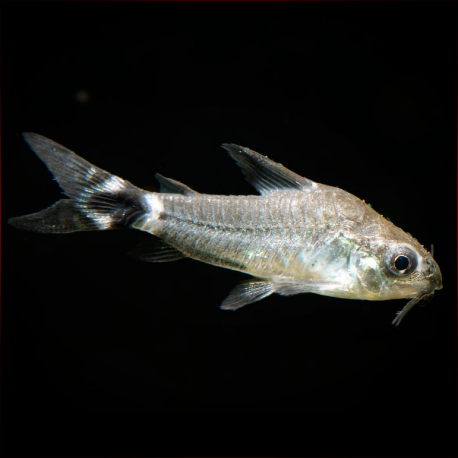More info
Datasheet
| Minimum Tank Size | 60 litres / 15.85 US gallons |
| Maximum Size | 3.2cm / 1.26inches |
| Temperature | 20°C / 68.00°F - 26°C / 78.80°F |
| Hardness | 2.02dgH / 36ppm - 12.05dgH / 215ppm |
| pH | 6.0-7.5 |
General Description
Corydoras Hastatus, commonly known as the Tail-Spot Pygmy Cory, belongs to the family Callichthyidae within the order Siluriformes. With a maximum size of 3.2 cm, it is distinguishable by a dark, roughly diamond-shaped spot on the caudal peduncle, setting it apart from similar species like C. pygmaeus. This species is an omnivore and displays unique adaptations for a pelagic lifestyle, exhibiting behavior different from most congeners.
Aquarium Setup
For optimal care, it is recommended to keep Corydoras Hastatus in groups of at least 4-6 individuals, ideally 10 or more. These fish are best suited to a tank with a minimum size of 60 litres, maintaining water parameters with a pH of 6.0-7.5, hardness of 36-215ppm, and a temperature range of 20-26°C. The tank should include fine sand substrate or clean gravel and provide hiding spots with driftwood, branches, leaf litter, and live vegetation.
Behaviour
Tail-Spot Pygmy Corys are peaceful and gregarious fish that prefer swimming in midwater and spend a significant amount of time away from the substrate. They exhibit schooling behavior and adapt to form mixed-species aggregations with other small characids, showcasing unique social interactions within the aquarium environment.
Feeding and Diet
As foraging omnivores, Corydoras Hastatus accepts sinking dried foods, small live, and frozen varieties like chironomid larvae and Tubifex. Unlike other species, they are adapted to consume pelagic zooplankton, making foods such as live Daphnia and Artemia essential for their diet. It is crucial to provide a varied diet as they do not thrive on leftovers and require specific nutritional intake.
Reproduction & Dimorphism
Breeding these fish follows a standard Corydoras method, with a higher ratio of males to females recommended during spawning. The females are visibly fuller with eggs, and a series of water changes with oxygenation triggers spawning. Eggs are typically laid on glass, vegetation, or spawning mops for easier removal. Females grow larger, showing broader and deeper bodies compared to males.
Habitat and Distribution
In their natural habitat, Corydoras Hastatus is found in marginal channels, swamps, and backwaters with clear-to-turbid water and muddy substrates. They are distributed across various regions of Brazil, Bolivia, Paraguay, and northeastern Argentina, demonstrating a vast range compared to other species in the genus. The species exhibits mimicry with other sympatric fish like Serrapinnus kriegi and Aphyocharax nattereri to protect against predators and coexist in their shared ecosystems.

